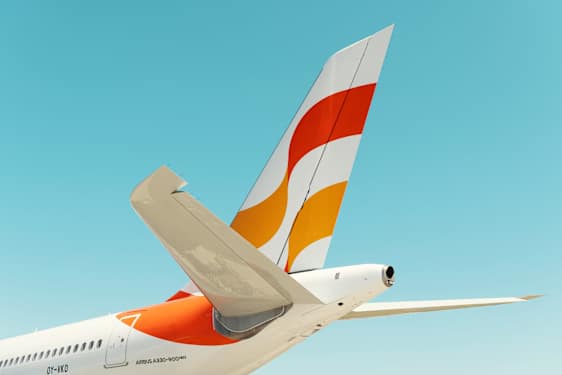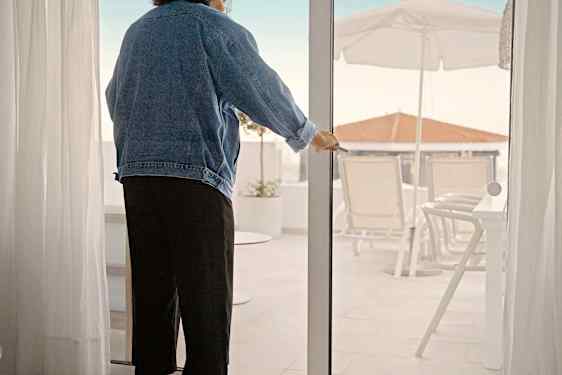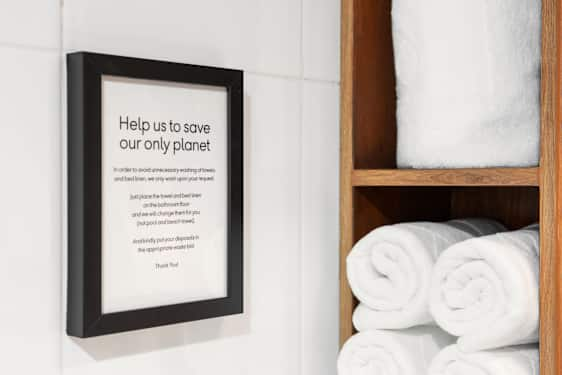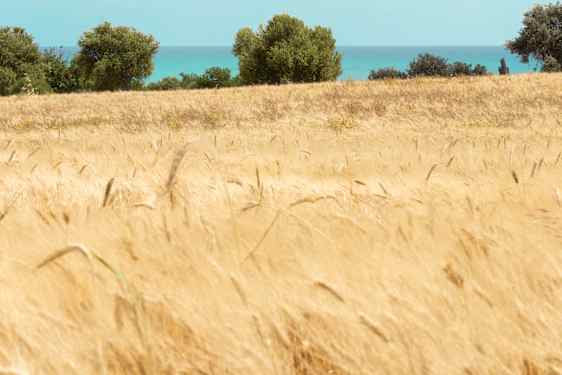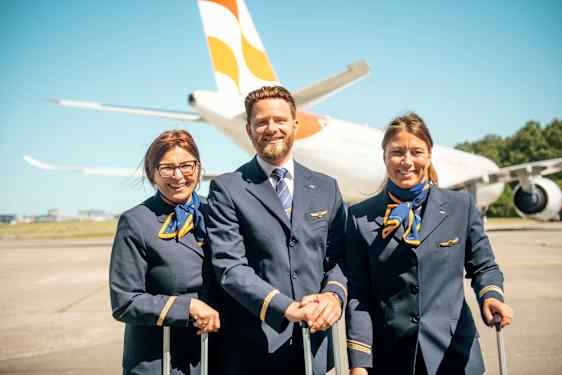Reducing emissions from Sunclass Airlines
Sunclass Airlines is by far the largest contributor to our carbon footprint. 2024, the airline contributed 99% of our scope 1 emissions and 79.6% of all calculated emissions from our operations. Therefore, our airline remains at the top of our emissions reduction agenda.
Our primary target is to reduce the emission footprint per passenger kilometre of the airline by 19% by 2030 compared to our 2023 baseline year. We are delighted that we are on track to reach this target. The target was SBTi approved in this reporting year, confirming that it is in line with international ambitions to limit global warming to 1.5C above pre-industrial levels, as laid out by the 2015 Paris Agreement. By 2040, we expect to have reduced the emissions footprint of the airline by up to 50%.
We have a three-point emission reduction plan in place for our airline business, with the ambition of delivering a net-zero result by 2050. All three points are integrated into Sunclass Airlines' operational processes and decision making.

Three-point plan to deliver a net-zero result by 2050
1. RENEWAL OF THE ENTIRE FLEET
In 2024, we replaced two A321ceo aircraft with two A321neos. These aircraft demonstrated a reduction in fuel use per hour up to 22% compared to the A321ceos. Through our fleet renewal programme, we will gradually replace all ceo aircrafts in our fleet with neos, and the entire fleet will have been fully renewed by 2030.
2. INTRODUCING SUSTAINABLE AVIATION FUELS (SAF)
In 2022, we signed partnership agreements with two future e-fuel producers: Nordic Electrofuel in Norway and Arcadia in Denmark. Through these partnerships, we’re committed to supporting the production of e-fuel. With demand for SAF set to increase, it’s crucial that we help to support e-fuel production for the future. We’re using our position within the aviation and tourism industries to push this agenda forward. In 2025, we expect to fly with a blend of 98% conventional jet fuel and 2% biogenic SAF on our flights that originate in an EU airport. The percentage is in accordance with the EU legislative mandate. Through our cooperation with ClimatePoint, we have invested funds in Nordic Electrofuel to contribute to their successful start-up of e-fuel production in 2026- 2027. Discussions are ongoing with our current fuel suppliers to encourage them to become involved in the SAF agenda and to ensure that our Sunclass Airlines has the SAF necessary to deliver on our ambitious targets.
3. DEVELOPING MORE EFFICIENT WAYS OF FLYING
The efficient utilisation of our fleet is essential. Any flight with empty seats impacts negatively on our overall environmental performance. Our tour operator companies and Sunclass Airlines work together to ensure the best possible utilisation of aircraft capacity and seats. This work encompasses many areas, from traffic composition and aircraft positioning to the opening and closing of destinations. However, sometimes unplanned situations cannot be avoided, such as natural disasters at our destinations – like the wildfires in Rhodes in 2023. In these cases, it may be necessary to fly an empty aircraft out of the Nordics to bring guests home safely from the destination in advance of the scheduled departure date.
DID YOU KNOW
Used cooking oil can help to power the aircraft engines of our planes. It is currently the most widely used source of sustainable fuels used by the airline sector.
Biofuel can be made from many sustainable sources, not just cooking oils, including municipal waste, plant oils, agricultural residues and non-biological sources.
These fuels have the potential to reduce emissions on a lifecycle basis, typically by up to 80% compared with conventional jet fuel.

In 2024, we worked to further refine and optimise our fuel management programme. However, we also realised that we require further operational data to fully exploit new fuel-saving opportunities not yet covered by our current efforts. So, Sunclass Airlines decided to invest in the world’s leading fuelsaving software: SkyBreathe from OpenAirlines. SkyBreathe collects data from the aircraft's Flight Data Monitoring systems, the flight plan and the operational systems, along with weather information. It then analyses this data to enable Sunclass Airlines’ Fuel Management department and pilots to identify fuel saving possibilities. The software will be an integral part of our fuel management programme in the coming years. We estimate that SkyBreathe will provide around 1% in fuel savings per year when fully implemented, equating to estimated CO2 savings of 2,700 tonnes annually. You can read more about our specific efforts to reduce emissions from our airline in the case story below.
A 3.2% REDUCTION IN CARBON EMISSIONS IN 2024
In our CO2 reduction journey for Sunclass Airlines, we report the climate impact from the airline using a key figure calculated by dividing our total fuel consumption during the specified period by the number of actual passenger kilometres flown. The calculation also includes fuel from any empty flights carried out during the period. Thanks to fleet renewal, a stabilised traffic pattern, an improved passenger load factor and an increased allocation of recourses to fuel saving, Sunclass Airlines delivered an impressive reduction in its carbon emission footprint of 64.4 grams of CO2 per passenger kilometre in 2024. That is a 3.2% reduction compared to last year’s 66.5 grams. Compared to industry standards, our carbon footprint figures are low, demonstrating the high efficiency of our aircraft operations.
Going the extra mile to reduce fuel use and emissions
When you want to hit net zero, every gram of carbon saved counts. At Sunclass Airlines, we’re working to reduce emissions from our operations by increasing fuel efficiency – one aircraft, one route and one flight at a time.

Meet Andreas Biering
Andreas has been a commercial pilot since 2015, and he loves flying with the Sunclass Airlines' fleet. When he’s not in the air, he’s working hard to bring down our aircraft's fuel consumption through smart initiatives, pilot training, data crunching and much more.
Andreas Biering is a man on a mission. A pilot by trade, Andreas still flies regularly. But today, most of his time is dedicated to a singular task: increasing the fuel efficiency of Sunclass Airlines’ fleet. This includes a full range of initiatives, from working with state-of-theart flight planning software to find the optimum 3-D trajectory through the air, to training pilots to make better-informed fuel-efficiency decisions in flight. “At NLTG, our mission is enriching life. We believe that tourism enriches life – for both individuals and communities – but we also understand that it has drawbacks,” says Andreas. “Flying people for leisure is carbon intensive. So, as a company, we have a duty to constantly reduce our impact on the environment, including emissions from our airline. That’s what fuel efficiency is all about.”

Every seat and initiative matters
There are many ways to measure and compare airlines when it comes to fuel efficiency. One of the most common is CO2 emissions per passenger kilometre. Sunclass Airlines operate with high load factors. On average, our revenue flights are almost completely full, with a load factor of 90-95%.
The switch to new neo-class aircraft is also a key driver in CO2 reductions. This type of aircraft emits around 20% less CO2 per passenger kilometre than the previous generation of aircraft. We are currently in the process of switching our fleet to neo-class and should have completed the transition by 2029. This is having a huge impact on our emissions.
But, to hit our target of a 50% reduction in emissions by 2040, we must still work each day to find new ways to increase fuel efficiency. This may be as simple as only taxiing with one engine, but it can also be more complex manoeuvres. For instance, encouraging pilots to use Reduced Acceleration Altitude, a concept that sees them switch from take-off mode to flight mode earlier in the flight in order to benefit from better aerodynamics. Implementing measures like this may only reduce CO2 by a small amount, but in the drive to reduce emissions, every initiative counts.
“There are hundreds of factors that affect fuel efficiency on an aircraft and many of them are out of our hands,” explains Andreas. “For example, in a season with more headwind, aircraft will use more fuel and, as a consequence, emissions will go up. But there is still a lot we can do – and are doing – in the preflight and flight stage to reduce emissions.”

Turning on flightkeys
Sunclass Airlines took a significant step forward in the journey towards lower emissions in 2024 when it introduced FlightKeys, an advanced new flight planning software.
“Around six hours before a flight, FlightKeys begins planning the journey, analysing hundreds of data points, from weather conditions and windspeeds to flight traffic. It then produces a flight plan for the pilot to follow, including the route, altitudes and speed,” Andreas explains.
One of the key pieces of information from FlightKeys is how much fuel the pilot needs to take on board. This is important for emissions for a simple reason. Fuel adds weight and, on an aircraft, extra weight
increases emissions. “For every kilo of extra fuel you take on an aircraft, fuel consumption increases by around 3g per hour,” Andreas explains. “I’ve seen examples from FlightKeys where 10,200 kilos of required fuel
changed to 10,197 kilos in two hours, based on new data. This may not sound like a lot, but if you fly 10,000 flight legs a year, the impact is significant.” The numbers back this up. Since FlightKeys was introduced one year ago, Sunclass Airlines’ fuel use has dropped by 671 tonnes. That’s an estimated saving of DKK 4.7 million – and a CO2 emissions saving of around 2,110 tonnes. There are many ways to measure and compare airlines when it comes to fuel efficiency. One of the most common is CO2 emissions per passenger kilometre. Sunclass Airlines operate with high load factors. On average, our revenue flights are almost completely full, with a load factor of 90-95%.
The switch to new neo-class aircraft is also a key driver in CO2 reductions. This type of aircraft emits around 20% less CO2 per passenger kilometre than the previous generation of aircraft. We are currently in the process of switching our fleet to neo-class and should have completed the transition by 2029. This is having a huge impact on our emissions.
But, to hit our target of a 50% reduction in emissions by 2040, we must still work each day to find new ways to increase fuel efficiency. This may be as simple as only taxiing with one engine, but it can also be more complex manoeuvres. For instance, encouraging pilots to use Reduced Acceleration Altitude, a concept that sees them switch from take-off mode to flight mode earlier in the flight in order to benefit from better aerodynamics. Implementing measures like this may only reduce CO2 by a small amount, but in the drive to reduce emissions, every initiative counts.
“There are hundreds of factors that affect fuel efficiency on an aircraft and many of them are out of our hands,” explains Andreas. “For example, in a season with more headwind, aircraft will use more fuel and, as a consequence, emissions will go up. But there is still a lot we can do – and are doing – in the preflight and flight stage to reduce emissions.”


Training pilots in fuel efficency
While initiatives like FlightKeys are important, pilot training remains the heart and soul of increasing fuel efficiency. At Sunclass Airlines, pilots receive constant training – on the aircraft, in simulators, in state-of-theart Virtual Reality suites and in the classroom.
“Ultimately, the pilot is responsible for fuel efficiency on a flight, so we give them all necessary information and training they need to make the right choices. It’s about helping them adjust their behaviour to make the best fuel decisions – always with safety as number one priority,” says Andreas.
DID YOU KNOW
Sunclass Airlines’ new OpenAirlines fuelefficiency software helps pilots improve energy management during a flight. The new software should reduce fuel use by around 0.7% each year – leading to an emissions reduction of 3,250 tonnes of CO2 .

